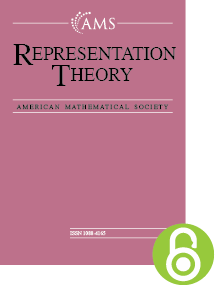Elliptic Weyl group elements and unipotent isometries with $p=2$
HTML articles powered by AMS MathViewer
- by George Lusztig and Ting Xue
- Represent. Theory 16 (2012), 270-275
- DOI: https://doi.org/10.1090/S1088-4165-2012-00415-0
- Published electronically: May 7, 2012
- PDF | Request permission
Abstract:
Let $G$ be a classical group over an algebraically closed field of characteristic $2$ and let $C$ be an elliptic conjugacy class in the Weyl group. In a previous paper the first named author associated to $C$ a unipotent conjugacy class $\Phi (C)$ of $G$. In this paper we show that $\Phi (C)$ can be characterized in terms of the closure relations between unipotent classes. Previously, the analogous result was known in odd characteristic and for exceptional groups in any characteristic.References
- G. Lusztig, From conjugacy classes in the Weyl group to unipotent classes, Represent. Theory 15 (2011), 494–530. MR 2833465, DOI 10.1090/S1088-4165-2011-00396-4
- G. Lusztig, Elliptic elements in a Weyl group: a homogeneity property, Represent. Theory 16 (2012), 189–211.
- Nicolas Spaltenstein, Classes unipotentes et sous-groupes de Borel, Lecture Notes in Mathematics, vol. 946, Springer-Verlag, Berlin-New York, 1982 (French). MR 672610, DOI 10.1007/BFb0096302
Bibliographic Information
- George Lusztig
- Affiliation: Department of Mathematics, Massachusetts Institute of Technology, Cambridge, Massachusetts 02139
- MR Author ID: 117100
- Ting Xue
- Affiliation: Department of Mathematics, Northwestern University, Evanston, Illinois 60208
- Received by editor(s): April 4, 2011
- Received by editor(s) in revised form: November 3, 2011
- Published electronically: May 7, 2012
- Additional Notes: The first author was supported in part by the National Science Foundation
- © Copyright 2012
American Mathematical Society
The copyright for this article reverts to public domain 28 years after publication. - Journal: Represent. Theory 16 (2012), 270-275
- MSC (2010): Primary 20G99
- DOI: https://doi.org/10.1090/S1088-4165-2012-00415-0
- MathSciNet review: 2915753


